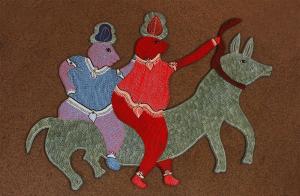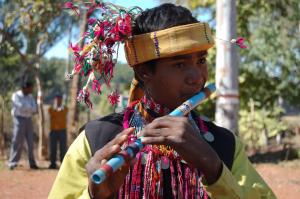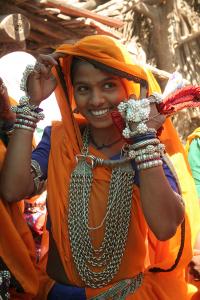Bhil tribal member adorned in traditional attire

A Vibrant Bhil Tribal Painting

Baiga Tribe of Madhya Pradesh
Celebrating the Diverse Cultures and Traditions of India’s Heartland
BHOPAL, MADHYA PRADESH, INDIA, May 24, 2024 /EINPresswire.com/ — Madhya Pradesh, often recognized as the heart of India, presents a diverse tapestry of cultures that define its essence. Beyond its scenic landscapes and historical landmarks, this central Indian state, with its rolling hills, cascading waterfalls, and life-giving rivers, has served as a natural haven for numerous tribal communities for centuries, providing insights into the ancient traditions and customs of its indigenous people.
These tribal communities thrive near rivers like Narmada, Tapti, and Chambal, and along mountain slopes that offer security and resources. The rivers provide water, fertile land, and spiritual significance, shaping their way of life.
With the highest tribal population in the country, constituting over 21% of its total inhabitants, Madhya Pradesh stands as a testament to India’s diverse cultural mosaic. Home to 46 recognized tribes and three Particularly Vulnerable Tribal Groups (PVTGs), the state showcases an extraordinary variety of languages, customs, and traditions, each rooted in distinct hereditary, cultural, and geographical environments.
The Bhil tribe, the largest in Madhya Pradesh and India, boasts a rich history and vibrant culture. Their traditional dances, such as Bhagoriya, and intricate folk paintings like Pithora, are emblematic of their deep-rooted customs and artistic expression. Similarly, the Gond tribe, spread across the Vindhya and Satpura ranges, offers insights into their distinct marriage practices and vibrant festivals like Karma and Madayi.
The Kol tribe, known for its ancient lineage mentioned in scriptures, showcases a rich cultural heritage with dances like Thieu Danka and Kol. Meanwhile, the Korku tribe, indigenous to Central India, presents a unique blend of agricultural practices and vibrant marriage traditions, deeply rooted in their reverence for nature and ancestral spirits.
Adding to this diverse tapestry are the Baiga and Sahariya tribes, known for their intricate tattooing traditions and unique blend of Animism and totem worship. Despite facing social and economic challenges, these communities continue to preserve their rich cultural heritage, enriching the cultural fabric of Madhya Pradesh.
In a pioneering initiative approved by the Government of India and orchestrated by the Madhya Pradesh Tourism Board, the Tribal Museum of Bhopal stands as a testament to the state’s commitment to preserving indigenous heritage. It showcases seven authentic dwellings representing the diverse tribal communities of Madhya Pradesh – Gond, Bhil, Baiga, Korku, Bharia, Sahariya, and Kol. These houses will now provide refuge to tribal families who will stay for three to six months on a rotation basis. Visitors will have the rare opportunity to immerse themselves in the daily lives of these communities housed within meticulously crafted traditional abodes. From mud-plastered bamboo walls to sacred idols adorning the exteriors, each dwelling offers a glimpse into the rich history of tribal culture.
Madhya Pradesh, an offbeat multispecialty destination of first choice, stands true to its title as the Madhya Pradesh Tourism Board (MPTB) recognizes the vital role tribal communities play in preserving the state’s cultural heritage. Through responsible tribal tourism initiatives, including the development of homestays in tribal villages and the promotion of tribal festivals, MPTB aims to support sustainable livelihoods while offering travelers immersive experiences into the heart of India’s tribal cultures.
Sanjay V Shetye
Vinsan Graphics
+91 98238 77416
email us here
Visit us on social media:
Facebook
Twitter
Instagram
YouTube
Times Passion Tribal Trail in Madhya Pradesh
![]()
Article originally published on www.einpresswire.com as Madhya Pradesh: A Mosaic of Cultures
The post Madhya Pradesh: A Mosaic of Cultures first appeared on Social Gov.
originally published at Global News - Social Gov


 ,
,